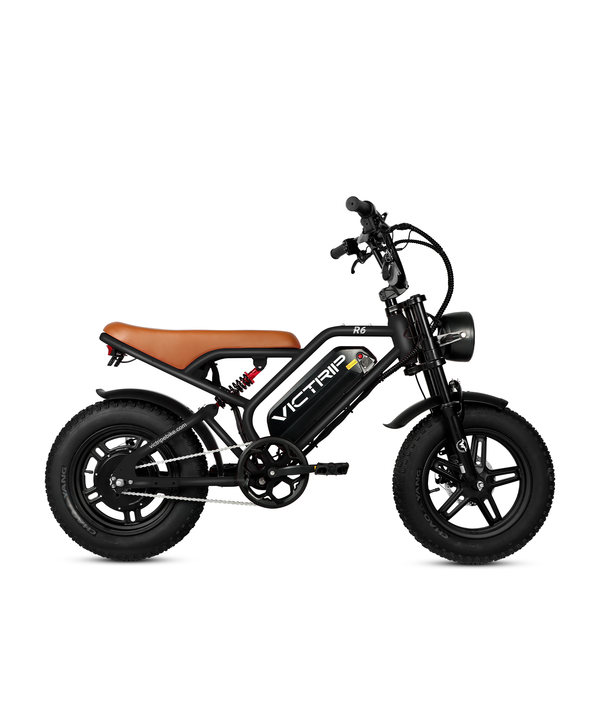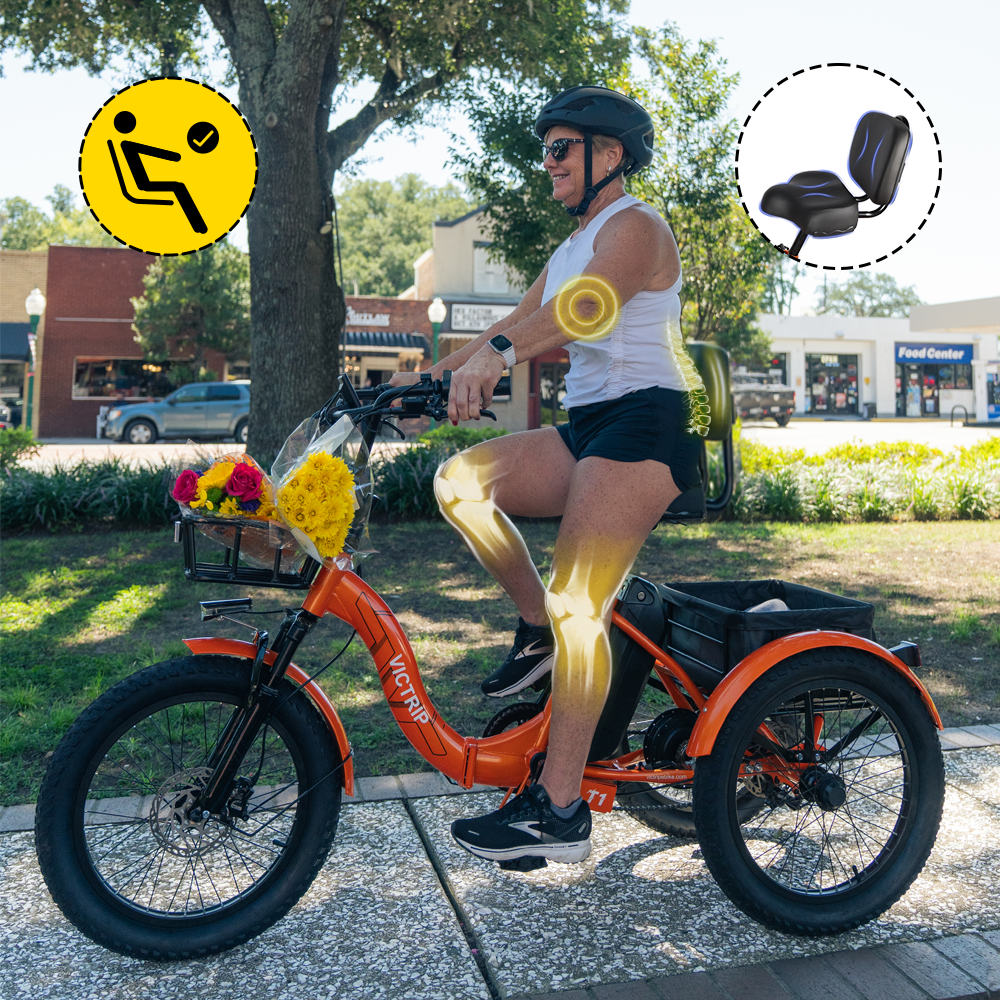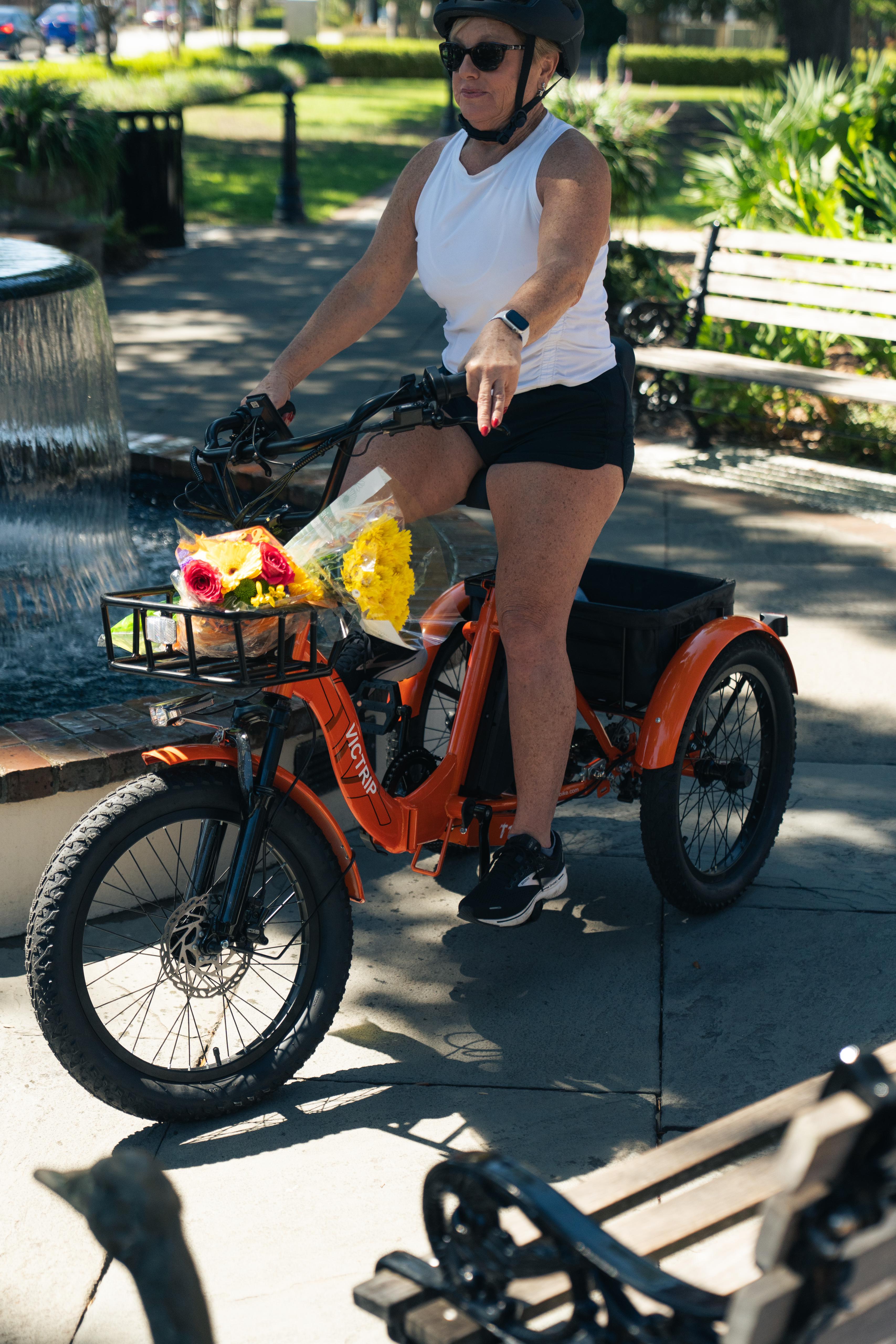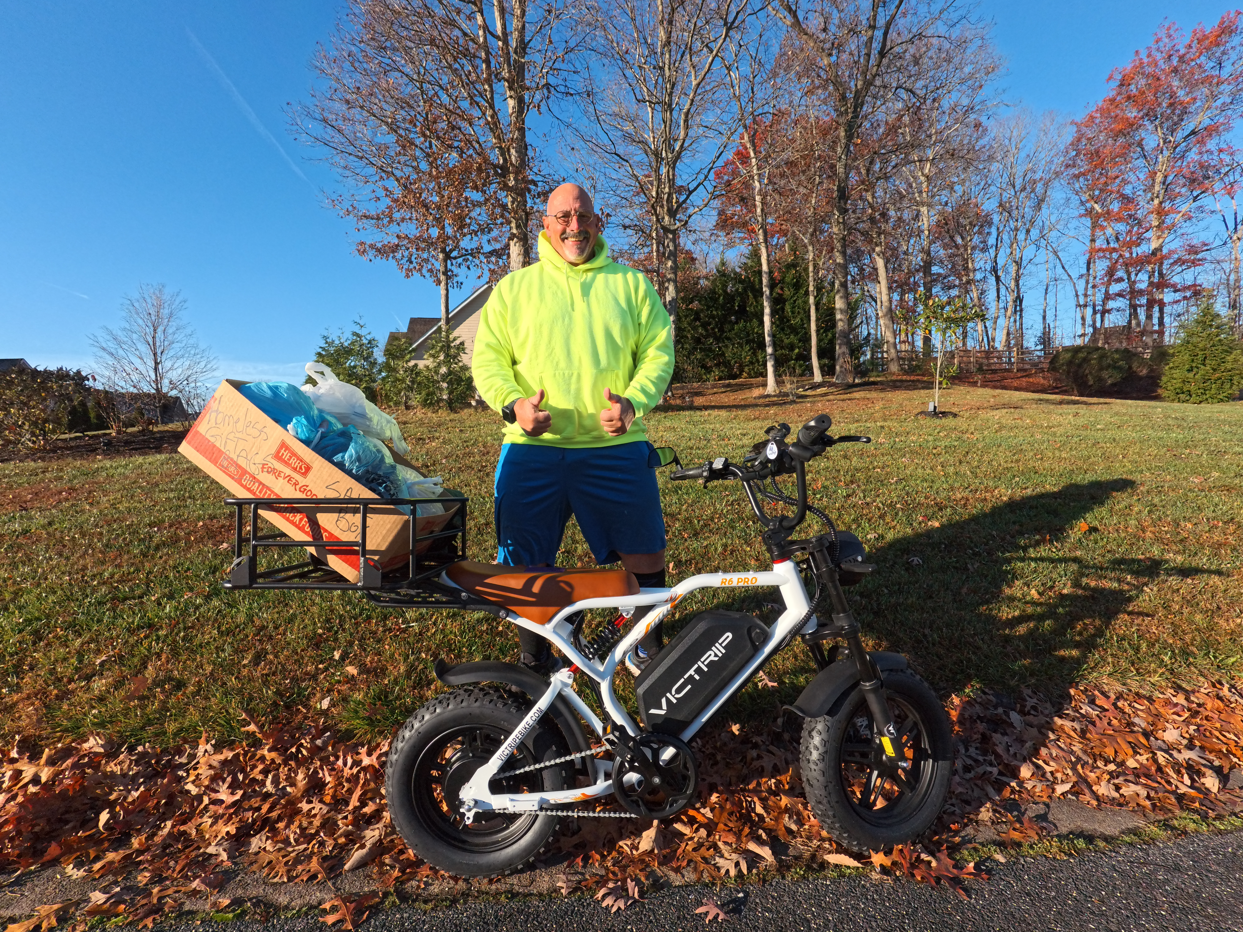
If you want the punch and posture of a motorcycle without the size, cost, or licensing hassle, a new class of ebikes has arrived to fill that gap. These models — often called moped-style or mini-motorcycle electric bikes — combine robust frames, fat tires, stronger motors, and comfortable saddles to give riders a motorcycle-like feel while remaining compact and often easier to own.
This article explains what gives these rides that “mini motorcycle” character, breaks down the key features to watch for, compares them with commuter e-bikes, and shows how the VICTRIP R6 fits into the market as a real-world example. You’ll get practical buying, safety, and maintenance guidance, plus an FAQ that answers the common concerns people have before they switch.
What is an “electric bike that feels like a mini motorcycle”?
Put simply, it’s an electric bicycle built to deliver the look, stance, and ride sensations of a small motorcycle while keeping the legal and ownership simplicity (in many areas) of an e-bike. These bikes typically combine:
-
heavier frames and beefy forks,
-
a long, padded saddle and forward or relaxed foot placement,
-
higher-torque motors with throttle capability,
-
larger battery packs and longer ranges than lightweight city e-bikes,
-
features like full suspension, large tires, and moped-style lighting.
Because of these attributes, the riding posture, steering feel, and acceleration often remind riders of a small motorcycle rather than a lightweight commuter bike.
Design elements that create the “mini motorcycle” feel
Frame and stance
The frame is usually more rigid and robust. Tubular frames, sometimes with a low center of gravity, mimic motorcycle geometry. This creates a planted, stable ride that feels heavier under you compared with a thin, upright commuter frame.
Seat and ergonomics
A long bench-style saddle, often with more cushioning, gives the kind of comfort you’d expect on a small bike or moped. Pedal placement may be forward or neutral rather than high, so your legs relax more on longer rides.

Handlebars and controls
Wider, motorcycle-style bars, bigger grips, and a clear throttle unit (in addition to pedal assist) give a tactile feel similar to a small motorcycle. Heavier steering at speed and mechanical/hydraulic disc brakes reinforce that sensation.
Wheels, tires, and suspension
These bikes often use fat or mid-fat tires (2.8”–4.0”), which add cushioning and traction. Many include front and rear suspension or at least a heavy-duty fork useful for mixed urban/off-road use.
Performance features: acceleration, torque, and speed
What really sets these bikes apart is how they accelerate and carry speed. Look for:
-
mid-drive or high-power hub motors (typical continuous ratings 500–750 W, peak often 1000 W or more),
-
higher torque figures (often 60–90 Nm or higher) for fast starts and hill climbing,
-
throttle modes for instant power without pedaling,
-
top speeds that can approach low moped limits (20–28+ mph, depending on configuration and local regulations).
A concrete example is the VICTRIP R6. The R6 is offered with a 750 W motor (1,000 W peak) and around 85 Nm of torque; its battery is listed as 624 Wh (48 V, 13 Ah) and the manufacturer advertises a top speed near 28 mph with PAS range figures up to 50+ miles in ideal conditions. These published specs highlight why riders get a mini-motorcycle impression from this model.
The VICTRIP R6 — quick spec snapshot and how it feels on the road
| Spec | VICTRIP R6 (manufacturer listing) |
|---|---|
| Motor | 750 W nominal (1,000 W peak). |
| Torque | ~85 Nm. |
| Battery | 48 V, 13 Ah (624 Wh) standard; options exist for larger packs. |
| Top speed | ~28 mph (depending on configuration & locale). |
| Range (advertised) | PAS up to 50+ miles; throttle 25–35 miles (conditions dependent). |
| Weight & fit notes | Compact, often recommended for shorter riders; fat tires and full suspension. |
Riding impression: the R6’s motor and torque deliver quick throttle response and confident acceleration for city merges and short freeway-style stretches where allowed. Fat tires and suspension absorb bumps and give a forgiving ride that feels more motorcycle-like than most commuter e-bikes. Real-world range will vary — independent tests and rider reports often show lower numbers than manufacturer claims.
TOP PICK

VICTRIP®R6 Off Road Ebike
Advantages of choosing a mini-motorcycle style e-bike
-
Stronger acceleration and confidence in mixed traffic. Higher torque and throttle modes help you merge and climb hills without straining.
-
Comfort for longer rides. Bigger saddles and relaxed ergonomics make commuting and weekend trips easier.
-
Versatility. Fat tires and suspension let you take rough paths, bike lanes, or light off-road trails.
-
Lower running costs than a gas moped or small motorcycle. Charging batteries costs far less than gas, and maintenance is usually simpler.
-
Simpler ownership in many places. Depending on power and speed, some models avoid registration and licensing requirements that apply to motorcycles — but always check local law.
Comparing mini-motorcycle e-bikes with traditional commuter e-bikes
Performance
Mini motorcycle e-bikes generally have stronger motors and higher torque. Commuter e-bikes prioritize efficiency, low weight, and compactness. If you want sprinting and hill power, a mini-motorcycle bike will usually outperform a commuter model.
Comfort & usability
Commuter bikes tend to be more upright and lighter for daily trips; mini-motorcycle bikes trade some lightness for comfort, suspension, and muscular presence.

Portability & storage
Commuter e-bikes are often easier to lift, fold, or fit in tight storage. Mini-motorcycle-style bikes are bulkier, heavier, and may not suit apartment stairways or small elevators.
Safety and legal considerations
-
Know local rules. In many countries or U.S. states, classification depends on motor power and top speed. Bikes that exceed certain speed or power thresholds may be legally treated as mopeds or motorcycles. Always check your local traffic code.
-
Wear appropriate gear. Even if no helmet is required where you live, a quality helmet and protective clothing are wise given the higher speeds involved.
-
Brake upgrades matter. Heavier, faster bikes need strong brakes. Look for solid disc brakes — hydraulic if possible — and good rotor sizes.
-
Visibility & lights. Moped-style lights, turn signals, and reflective surfaces help at night and in traffic. The VICTRIP EBike includes turn signals and a strong headlight as standard equipment.
Maintenance basics for longevity
-
Battery care. Avoid deep discharges when you can. Store at ~50% if you put the bike away for months. Charge fully before long trips and avoid extreme temperatures.
-
Brake and tire checks. Inspect brake pads and tire wear every few hundred miles.
-
Suspension care. Check seals and bearings periodically if your bike has full suspension.
-
Software/firmware updates. Some manufacturers issue updates to controllers and displays; apply them according to the vendor’s instructions.
How to choose the right model
-
What top speed do you need? Check local legal limits.
-
How far do you ride daily? Choose battery capacity accordingly.
-
What terrain will you cover? Fat tires and suspension help rough roads.
-
Rider height and weight: try before you buy if possible (some compact bikes suit shorter riders better).
-
Service & parts availability: prefer brands with local support if you want quicker repairs.
Top use cases — who benefits most?
-
commuters who want faster, more comfortable urban travel without a car,
-
short-distance delivery riders who need power and cargo capacity,
-
riders who mix paved roads and light trails,
-
people who want a motorbike feel but prefer lower costs and simpler ownership.
Common myths and clarifications
-
Myth: “They’re just more dangerous.”
Fact: Higher speeds increase risk, but the same is true of motorcycles. Proper gear, good brakes, and responsible riding greatly reduce danger. -
Myth: “They always need a license.”
Fact: Laws vary. Many e-bikes under particular power/speed thresholds remain bikes under the law; others become mopeds. Check local rules. -
Myth: “Range claims are exact.”
Fact: Manufacturer ranges are ideal-case numbers. Real-world range depends on rider weight, terrain, speed, and how often you use throttle vs pedal assist. Independent tests often show lower figures.
Short review: VICTRIP R6 — who should consider it?
The VICTRIP R6 is a compact, fat-tire, full-suspension moped-style ebike aimed at riders who want a fun, stable, and confident ride without the bulk of a full motorcycle. Its 750 W (1,000 W peak) motor and 624 Wh battery make it a good match for urban commuters who want frequent acceleration and the ability to handle hills and short off-road sections. The R6 is also often recommended for shorter riders because of its compact geometry and low step height.
Pros
-
Strong torque and quick acceleration.
-
Solid features for the price (lights, turn signals, suspension).
-
Good for mixed-surface riding.
Cons
-
Weight and bulk make it less portable.
-
Real-world range may be less than advertised under heavy load or high-speed riding.

Short comparison table — mini-motorcycle e-bike vs commuter e-bike
| Feature | Mini-motorcycle e-bike | Commuter e-bike |
|---|---|---|
| Power & torque | High (500–1000W+; 60–90+ Nm) | Low–medium (250–500W) |
| Top speed | 20–28+ mph | 15–20 mph |
| Comfort | Longer saddle, suspension | Upright, lighter |
| Weight | Heavier | Lighter |
| Portability | Low | High |
| Price | Mid–high | Low–mid |
Final considerations and next steps
If you’re intrigued by the idea of an electric bike that feels like a mini motorcycle, start by identifying local legal limits and your daily range needs. Try to test ride at least two models in the same class — one compact like the VICTRIP R6 and one larger model — to judge comfort and handling. Also check warranty coverage and where you’ll get service.
Conclusion — why now is a good time to consider one
These bikes blend elements of motorcycles and bicycles in a way that makes daily travel more enjoyable and flexible for many riders. They’re especially compelling if you want stronger acceleration, more comfort for longer rides, or a bike that can handle mixed terrain. Bikes like the VICTRIP R6 showcase how accessible this category has become: competent power, built-in safety features, and a price that’s often far below a gas-powered moped. If the combination of agility, power, and convenience sounds appealing, trying a mini-motorcycle e-bike could be the right next step.
FAQs
Is a mini-motorcycle e-bike legally the same as a regular e-bike?
It depends on your jurisdiction and the bike’s power/speed. Many places define e-bikes by motor wattage and top speed. If a model exceeds local thresholds, it could be classed as a moped or motorcycle and require registration, insurance, and a license.
How far will a bike like the VICTRIP R6 go on a charge?
Manufacturer PAS claims for the R6 list up to 50+ miles under ideal conditions, while throttle-only ranges are often 25–35 miles. Real-world user tests frequently show shorter ranges (often 17–30 miles depending on terrain, speed, and rider weight). Use the manufacturer’s number as a best-case reference.
Do you need a motorcycle license to ride one?
Not always. If the e-bike’s top speed or motor power pushes it into a higher class, local law may require a license. Check your state or country rules.
Can you ride one in bike lanes?
That depends on local law and the specific speed/power classification of the bike. Some regions allow higher-powered e-bikes in bike lanes, others don’t.
Are mini-motorcycle e-bikes worth the price?
If you value acceleration, comfort, and mixed-terrain capability, they often are. They cost more than basic commuter e-bikes but usually less than a gas moped or motorcycle and have lower operating costs.




Share:
Beach Cruiser Vs Commuter EBike? What are the differences?
Gears & Shifting: Single Speed vs. Multi Speed E-Bikes